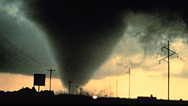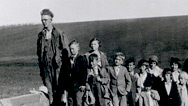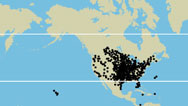Tracking Twisters With Radar
- By David Levin
- Posted 03.30.04
- NOVA
Tornadoes can form quickly, making it tough to warn people in advance. Existing radar networks are only a partial solution. They're good at finding large weather systems that might cause tornadoes but normally can't spot funnels as they touch down. Dave McLaughlin, a radar specialist at the University of Massachusetts in Amherst, wants to eliminate such blind spots with a new radar just a 50th the size of the big systems.
Transcript
Tracking Twisters With Radar
Posted March 30, 2004
DAVID LEVIN: You're listening to a NOVA podcast.
It's tornado season again, and deadly storms have already begun.
TV NEWSCASTER: We got a funnel on the ground right now, righthand side! Tornado on the ground! If you haven't got down to the cellar or basement, you really need to go now. This is a huge circulation.
DAVID LEVIN: For much of the late spring, weather experts are on their toes. Compared to a storm front, tornadoes are small and isolated. They can form quickly, making it tough to warn people in advance. Existing radar networks are only a partial solution. They can find big weather systems that might cause tornadoes but normally can't spot funnels as they touch down.
Dave McLaughlin is a radar specialist at the University of Massachusetts in Amherst. For the last three years, he's led a team of researchers from around the country trying to solve this problem.
DAVE MCLAUGHLIN: Today's weather observing system can't actually see down close down to the ground. And that's certainly where all hazardous weather impacts us. It was really designed to do a very good job looking 10,000 feet and up. So all of that interesting soup close to the ground is literally under the radar screen of today's system.
DAVID LEVIN: Right now, that system is a web of 158 giant radar dishes around the country. According to McLaughlin, it's limited by its size. Even if the dishes were focused near the ground, they could still only see to the horizon, leaving huge blind spots where tornadoes actually happen.
DAVE MCLAUGHLIN: So you'll probably start to see the system in a clearing in the hills. Here, we'll get up closer to it.
DAVID LEVIN: On a rainy day in Amherst, McLaughlin drives towards what may be the future of tornado detection. It doesn't look like much—just a small white dome on a 60-foot scaffold.
DAVE MCLAUGHLIN: This is the prototype for the system that we produced and brought out to Oklahoma. The antenna is a 50th the size of the big systems that are in use by the weather service today. And the total power transmitted is about a fifth the power of a light bulb. So the idea is a large number of these very small radars, each one only transmitting a couple tens of watts of power, and then together they make up the network that comprehensively maps down low.
DAVID LEVIN: Instead of using a few hundred huge radars like today's system, McLaughlin's team wants to install thousands of these mini-radars all over the Midwest. Planted on cellphone towers and rooftops, they would be close enough together to eliminate blind spots altogether.
DAVE MCLAUGHLIN: A system like this really has tremendous potential to lock its crosshairs on individual tornadoes, triangulate on those, and actually follow them down individual streets. And that has great potential to improve how we do warning of individual tornadoes.
DAVID LEVIN: Since early February, four of these units have been installed in Oklahoma, on a grid covering more than 4,000 square miles of grassland. Even though they're just prototypes, they've already won the approval of local forecasters and emergency workers. Steve Chapman is the emergency management director for the city of Chickasha, Oklahoma, just southwest of Oklahoma city.
STEVE CHAPMAN: Oh, there's no doubt that it will make our job easier. The resolution is so detailed, it will provide us additional warning time to the citizens, and help reduce the false alarm rate that is caused by the current system. It's a simple matter of "crying wolf." If you blow the siren only on verified storms, then the citizens come to understand that that's the actual thing and they need to take action immediately and not try to drive to grandma's house or whatever. A few minutes is the difference between saving lives and not saving lives.
DAVID LEVIN: As the resolution and coverage of these new radar units improves, their pinpoint accuracy might lead to something almost unheard of: an entire season without a single tornado-related death.
For NOVA, I'm David Levin.
Related Links
-

Hunt for the Supertwister
Tornado-chasing scientists with an eye to better forecasting plumb the secrets of nature's most terrifying killer.
-

Rate Tornado Damage
Use the Fujita Scale of tornado intensity to assess the level of destruction left in the wake of actual tornadoes.
-

Killer Tornado of 1928
The remarkable story of 17-year-old Dale Larson and 29 Nebraskan schoolchildren shows how far tornado warning has come.
-

Tornado Country
How is it that with nearly 200 nations in the world, just one—the U.S.—gets up to three-quarters of all t...
You need the Flash Player plug-in to view this content.

